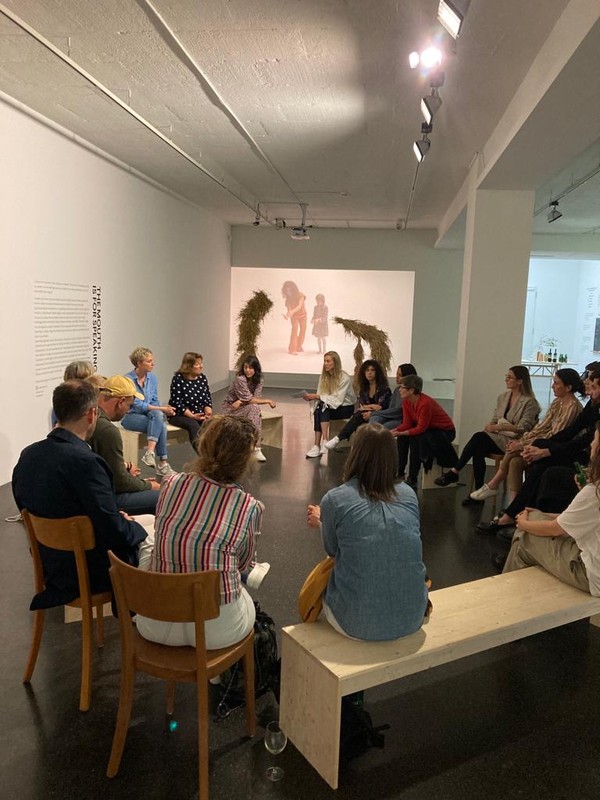
English version below
WIE WIRD DIE STADT IN 100 JAHREN AUSSEHEN?
Co- Habitations: Urban Resilience through Art
Mit verschiedenen Gemeinschaften zusammen möchten wir Visionen für die Zukunft mitgestalten. Lass uns zusammen die Beziehung zu unserer Umwelt positiv verändern.
Was ist die Hauptidee des Projekts?
Die Leitidee von Co-Habitations kreist um die Frage „Wie wird die Stadt in 100 Jahren aussehen?“ Und: wie wird sich unser Leben durch den Klimawandel verändern?
Alle Grünflächen in Zürich sind überbevölkert, Paris, New York und weitere Städte haben initiativen für die Begrünung der Stadt lanciert. In Paris muss jede Grünfläche in fünf Minuten zu Fuss erreichbar sein. Wir möchten die Zukunft unserer Stadt zusammen mitgestalten.
Wer sind wir und wen möchten wir in den Dialog miteinbeziehen?
Um möglichst viel Expertise zusammen zu tragen, arbeiten wir als Kollektiv. Co-Habitations ist ein transdisziplinäres Projekt von Kurator:innen, Künstler:innen, Ökolog:innen, Aktivistinnen, Architekt:innen, Besucher:innen, etc.
Auch Einwohner:innen dieser Stadt, Kulturvereine, Interessensgemeinschaften sind Teil des Projekts.
Das Resultat soll ein Netzwerk von Ideen sein, das nach dem Ende des Projekts weiterlebt.
Welche Rolle spielt der Pavillon?
Als Treffpunkt, Vermittlungsort, und Musterbau ökologischer Bauweise realisieren wir einen Pavillon zusammen mit der ETH, welcher in einem Wohnquartier verankert ist. Der Pavillon wird zu einem Verbindungsglied für alle Gemeinschaften verschiedener Disziplinen, zum Ort für Wissens-und Gemeinschaftsbildung, wo Wissen erlebbar ist in Workshops, Abendessen und vielen weiteren Aktivitäten. Jeden Tag wird ein öffentliches Programm angeboten, welches sich an verschiedene Altersgruppen richtet.
Wir wollen das abstrakte Problem der globalen Erwärmung greifbar machen und erforschen, wie es sich in verschiedenen Gemeinschaften manifestiert.
Wie sieht das finale Projekt aus?
Co-Habitations ist mehr Prozess als finales Produkt. Das Projekt ist insgesamt ein Katalysator für Veränderungen, indem wir gemeinsam nach unerwarteten und machbaren Lösungen suchen, welche auf gemeinschaftlicher und individueller Ebene umgesetzt werden können. Als Abschluss planen wir einen Print-on-demand Almanach in dem in verschiedenen Sprachen und Bildern, das gewonnene Wissen festgehalten wird sowie eine gemeinsam entwickelte Aktion, die wir am Ende des Projekts zusammen durchführen.
Kernteam:
Martina Huber, Vernetzerin
Alexandra Eichenauer, Lernen mit Kindern
Carolina Brunelli, Künstlerin und Brückenbauerin
Ishita Chakraborty, Künstlerin
Violeta Burckhardt, Architektin und Städteplanerin
Maurice Maggi, Künstler, Koch und Klimaaktivist
Raphael Portmann, Klimawissenschaftler
Maya Minder, Künstlerin
Partner:
ETH Zürich, Nachhaltiges Bauen, Inst. Bau- & Infrastrukturmanagement
ZHAW, Forschungsgruppe Nachhaltigkeitskommunikation und Umweltbildung
Degrowth Schweiz
compagnie O., Marie Alexis
ICT4Peace, Leben retten durch Informations- und Kommunikationstechnologie
Robert F. Kennedy Human Rights Switzerland, Bildungsprogramm für und mit Schulklassen
Many more to come…
UEBER AIA
WE ARE AIA I Awareness in Art – ein gemeinnütziger Verein, dessen Leitbild es ist, durch Kunst Bewusstsein für gesellschaftspolitische Themen zu schaffen. Als Kunstplattform produzieren wir herausragende Ausstellungs- und Vermittlungsprojekte, die einen interdisziplinären Denk- und Forschungsraum zu Ökologie, Gesellschaft, Technik und Wissenschaft anregen.
EN
WHAT WILL THE CITY LOOK LIKE IN 100 YEARS?
Co- Habitations: Urban Resilience through Art
We want to make the abstract problem of global warming tangible and explore how it manifests itself in different communities. Learning how to change our relationship with the environment from parasitic to symbiotic one is the main objective of the project.
Learning from the elderly and from young generations, learning through discussion and through collective and individual acts.
What is the main idea of the project?
The central idea of Co-Habitations revolves around the question "What will the city look like in 100 years?" And how will our lives change as a result of climate change and how are the different communities affected by it?
Who are we and who do we want to involve in the dialogue?
In order to bring together as much expertise as possible, we work as a collective. Co-Habitations is a transdisciplinary project by curators, artists, ecologists, activists, architects, visitors, etc.
Residents of this city, cultural associations, different local communities are also part of the project.
The result is a network of ideas that will live on after the end of the project.
Together we would like to help shape visions for the future and communicate them to the outside world.
What role does the pavilion play?
As a meeting place, place of mediation and model of ecological construction, we will conceive a pavilion together with the ETH Zurich, the pavilion is anchored in a residential area. It will become a link for all communities of different disciplines, a place for knowledge and community building, where knowledge can be experienced in workshops, dinners and many other activities. A public program aimed at different age groups will be offered every day.
What does the final project look like?
Co-Habitations is more of a process than a final product, a platform for exchange, experiencing art and being part of the project instead of just looking at a final product.
Overall, the project is a catalyst for change, in which we look together for unexpected and feasible solutions that can be implemented on a collective and individual level. As a conclusion, we are planning a print-on-demand almanac in which the knowledge gained will be recorded in different languages and pictures, as well as a joint action that we will carry out together at the end of the project.
Team members:
Martina Huber, curator, and founder
Alexandra Eichenauer, Art Mediator
Carolina Brunelli, Curatorial Assistant / Artist
Ishita Chakraborty, Artist
Violeta Burckhardt, Architect and Curator
Maurice Maggi, Artist, Chef and Activist
Raphael Portmann, Climate Scientist
Maya Minder, Artist
ETH Zurich, Sustainable Building, Inst. Building & Infrastructure Management
ZHAW, Research Group Sustainability Communication and Environmental Education
Degrowth Switzerland
Company O., Marie Alexis, experience the earth through your body.
ICT4Peace, saving lives through information and communication technology
Robert F. Kennedy Human Rights Switzerland, youth amabassadors and educational programs with school classes
Many more to come…
About AIA:
WE ARE AIA I Awareness in Art - a non-profit association whose guiding principle is to generate awareness for socio-political issues through art. As an art Platform, we are producing outstanding exhibition and mediation projects that stimulate an interdisciplinary thinking and research space on ecology, society, technology, and science.


